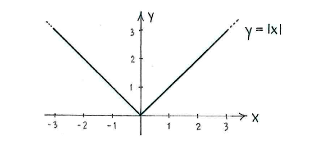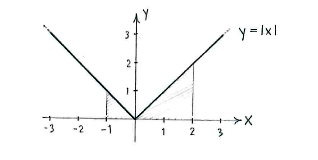Lösung 2.1:1d
Aus Online Mathematik Brückenkurs 2
(Unterschied zwischen Versionen)
K (Solution 2.1:1d moved to Lösung 2.1:1d: Robot: moved page) |
|||
| Zeile 1: | Zeile 1: | ||
| - | + | Die Betragsfunktion <math>|x|</math>, returniert den Betrag von <math>x</math>, und nimmt also das Vorzeichen von <math>x</math> weg. Zum Beispiel ist | |
{{Abgesetzte Formel||<math>|-5|=5\,</math>, <math>\quad|3|=3\quad</math> and <math>\quad |-\pi|=\pi\,</math>.}} | {{Abgesetzte Formel||<math>|-5|=5\,</math>, <math>\quad|3|=3\quad</math> and <math>\quad |-\pi|=\pi\,</math>.}} | ||
| - | + | Für positive <math>x</math>, ändert die Betragsfunktion nichts, nachdem | |
| - | <math>|x|=x</math>, | + | <math>|x|=x</math>, während die Betragsfunktion für negative <math>x</math> das Vorzeichen von <math>x</math>, i.e. <math>|x|=-x</math> ändert. |
| - | + | ||
| - | + | Zeichnen wir den Graph von <math>y=|x|</math> besteht er aus zwei Teilen. Für | |
| - | <math>x\ge 0</math> | + | <math>x\ge 0</math>ist <math>y=x</math>, und für <math>x\le 0</math> ist |
<math>y=-x\,</math>. | <math>y=-x\,</math>. | ||
[[Image:2_1_1_d1.gif|center]] | [[Image:2_1_1_d1.gif|center]] | ||
| - | + | Daher ist das Integral die Fläche unter der Funktion <math>y=|x|</math> zwischen <math>x=-1</math> und <math>x=2</math>. | |
[[Image:2_1_1_d2.gif|center]] | [[Image:2_1_1_d2.gif|center]] | ||
| - | + | Nachdem das Gebiet aus zwei Dreiecken besteht erhalten wir | |
{{Abgesetzte Formel||<math>\int\limits_{-1}^{2} |x|\,dx = \frac{1}{2}\cdot 1\cdot 1 + \frac{1}{2}\cdot 2\cdot 2 = \frac{5}{2}\,\textrm{.}</math>}} | {{Abgesetzte Formel||<math>\int\limits_{-1}^{2} |x|\,dx = \frac{1}{2}\cdot 1\cdot 1 + \frac{1}{2}\cdot 2\cdot 2 = \frac{5}{2}\,\textrm{.}</math>}} | ||
Version vom 16:30, 28. Apr. 2009
Die Betragsfunktion \displaystyle |x|, returniert den Betrag von \displaystyle x, und nimmt also das Vorzeichen von \displaystyle x weg. Zum Beispiel ist
| \displaystyle |-5|=5\,, \displaystyle \quad|3|=3\quad and \displaystyle \quad |-\pi|=\pi\,. |
Für positive \displaystyle x, ändert die Betragsfunktion nichts, nachdem \displaystyle |x|=x, während die Betragsfunktion für negative \displaystyle x das Vorzeichen von \displaystyle x, i.e. \displaystyle |x|=-x ändert.
Zeichnen wir den Graph von \displaystyle y=|x| besteht er aus zwei Teilen. Für \displaystyle x\ge 0ist \displaystyle y=x, und für \displaystyle x\le 0 ist \displaystyle y=-x\,.
Daher ist das Integral die Fläche unter der Funktion \displaystyle y=|x| zwischen \displaystyle x=-1 und \displaystyle x=2.
Nachdem das Gebiet aus zwei Dreiecken besteht erhalten wir
| \displaystyle \int\limits_{-1}^{2} |x|\,dx = \frac{1}{2}\cdot 1\cdot 1 + \frac{1}{2}\cdot 2\cdot 2 = \frac{5}{2}\,\textrm{.} |


